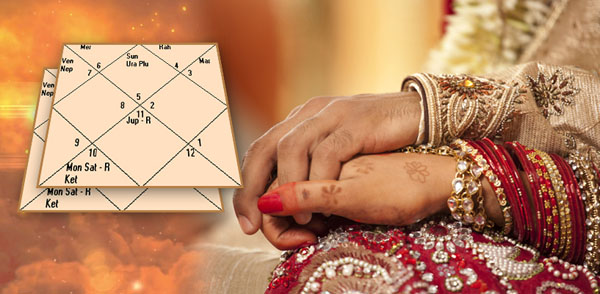In Indian culture, marriages are literally Made in Heaven and the compatibility of the couple in marriage can be judged by matching their Kundali or Vedic Horoscopes. Vedic Astrology provides us with divine insight into every area of life and our ancient Yogis have perfected the science of reading the planets, stars, and houses in a natal chart. The age-old methodology primarily practiced in Northern India for matching the compatibility factors of between a prospective couple is known as the Vedic Ashtakoot Guna Milan, while the methodology practiced in Southern India is known as the Dashakoot Guna Milan. The latter method is generally considered to be more comprehensive than the former method.
A brief explanation of the calculation methodology in these two systems are:
- Ashtakoot divides the natal charts into 8 (Ashta) Aspects (Koot): Nadi (8), Bhavkoot (7), Gana (6), Maitri (5), Yoni (4), Tara (3), Vasaya (2) and Varna (1)
- Dashakoot divides the natal charts into 10 (Dasha) Aspects (Koot): Dina (3), Gana (4), Yoni (4), Rashi (7), Rasyadhipati (5), Rajju (5), Vedha (2), Vashya (2), Mahendra (2), StreeDeergha (2)
The maximum Guna or Weightage assigned to each Koot is mentioned above in parenthesis next to each aspect, adding up to a maximum score of 36 points. If the maximum compatibility score for the prospective couple is 36 points, then the match is considered to be “Made in Heaven”. However, anything less than 18 points is not considered a suitable match for marriage.
Both Asthakoot and Dashakoot analysis methods are just elementary investigations resulting in computing a compatibility score for a prospective couple but they are nowhere near to actual matching all aspects within the natal charts. Standalone, they are simplistic and naïve approaches to look at the “Compatibility Quotient” categorized as Poor, Average, Good or Excellent based on the total score out of 36 points of the prospective couple based on the above methods. There are many marriages that are running successfully even after attaining a low compatibility score on Kundali matching and there are many others that have much turbulence even after a very securing a high compatibility score.
A major lacuna in following the above methods to arrive at a score out of a maximum possible score of 36 by just totaling the Guna or Weightage assigned to each Koot or Aspect, is this approach does not take into account cancellation of any Mahadoshas i.e. Gana, Bhakoot and Nadi and do not make provision to add back the Guna score deducted if any of them was canceled, as mentioned in our ancient Vedic Muhurta Granthas.
Kundali Reading for marriage to be successful, Kundali Milan is only one of the several factors to be looked into. We must give prime importance to the in-depth analysis of the following aspects for holistic appraisal of marital compatibility:
- a) Koota Matching b) Kuja Dosha Matching c) Lagna Chart Matching
- d) Aroodha Lagna Matching e) Navamamsa Matching f) Asthakavarga Matching
The Natal charts, Navamansh charts, 7th house, and the other related houses and planets for marital happiness as well as the current and forthcoming Doshas, all crucial insight into how well the two partners match at spiritual, social, monetary, emotional, mental, intellectual, attitudinal, physical and sexual levels.
Kundali Reading for marriage in our ancient Vedic astrology has devised several principles to evaluate the matching of horoscopes so that it may be a lasting marriage. Divinity World always recommends to search for accurate horoscopes and consult an astrologer who does the Kundali matching analysis based on such a holistic and comprehensive view.
